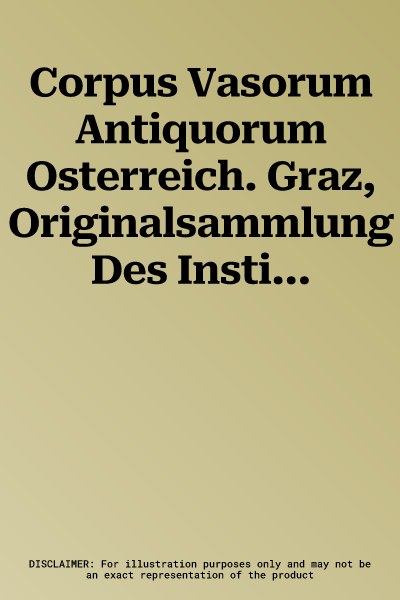English summary: The first volume of the Corpus Vasorum Antiquorum- Graz
contains a total of 93 objects, which originated from workshops in the
region of the Greek east and Cyprus as well as the Greek mainland and
southern Italy. The pieces, which for the most part are presented here
for the first time in a scholarly fashion, span not only regional
boundaries but also periods of time, and offer a broad spectrum of
various types of ancient ceramics. The vases presented in this work are
part of the original collection of the Archeological Institute of the
Karl-Franzens-University in Graz, which has operated as a collection for
scholarly study since 1865. This volume presents nearly wholly-intact
vessels from Bronze Age Cyprus (c.2000 BCE), which are presented for the
first time, with the exception of a beak-spouted jug that appeared in
the fundamental work The Middle Cypriote Bronze Age (The Swedish Cyprus
Expedition IV 1 b, Lund 1972.) Among the geometrically decorated
vessels, some are particularly noteworthy as they are derived from the
Kerameikos of Athens. In particular, among these specimens is a fragment
from workshop of the Dipylon Master, which matches fragments in
Gottingen and Athens and which leads to further considerations regarding
the affiliation of Dipylon vessels. Among the Corinthian ceramics, two
alabastra (or small vessels) from the luxury group are presented here,
which are notable not only for their ornamental painting but also for
their origin in the princely tomb of the Fourteen Bridges in Capua. The
most prominent form of decoration, though, is doubtless the Attic
red-figure style from the 5th century, whose progression is documented
through a hydria (a water-carrying vessel) of a Berlin painter, three
amphorae from Nola, Italy and a series of kylixes (drinking vessels).
Attic lusterware as well as Boeotic and Etruscan products are also
presented in this volume as well as southern Italian vases from Apulian,
Campanian, Sicilian, and Lucanian workshops. Of particular importance
among this group, on the basis of its frieze-like, narrative
representation, but also because of the high quality of its decoration,
is a lid to a pyxis from Campania. Even a collection like that of the
Institute in Graz, which was assembled less for its aesthetic highlights
and more for academic purposes, is able to give insight into the various
enigmas, which as engagement with ancient ceramics still offers us.
German description: Der erste Band des CVA Graz enthalt insgesamt 93
Objekte, die von Werkstatten im Raum griechischer Osten uber Zypern und
griechisches Mutterland bis Unteritalien stammen. Die Werkstucke, die
der Fachwelt zu einem grossen Teil erstmals vorgestellt werden, spannen
aber nicht nur raumlich, sondern auch zeitlich einen grossen Bogen und
bieten ein breites Spektrum unterschiedlichster Gattungen antiker
Keramik. Die prasentierten Vasen sind Teil der Originalsammlung des
Instituts fur Archaologie der Karl-Franzens-Universitat Graz, die aus
einer bereits 1865 ins Leben gerufenen Lehrsammlung hervorgegangen
ist.Der Band legt sechs fast komplett erhaltene Gefasse der zyprischen
Bronzezeit des 2. Jahrtausends v. Chr. vor, die mit Ausnahme einer
Schnabelkanne, welche bereits in dem Grundlagenwerk "The Middle Cypriote
Bronze Age" (The Swedish Cyprus Expedition IV 1 b, Lund 1972)
aufscheint, erstmals gezeigt werden.Unter den geometrischen Gefassen
sind besonders Objekte hervorzuheben, die aus dem Kerameikos von Athen
stammen, darunter ein Fragment der Dipylon-Werkstatt, das an Fragmente
in Gottingen und Athen anpasst und zu weiteren Uberlegungen bezuglich
Zusammengehorigkeiten von Dipylon-Gefassen fuhrt. Bei der korinthischen
Keramik treten zwei Alabastra der Luxus-Gruppe hervor, die nicht nur
aufgrund ihrer Bemalung auffallen, sondern auch aufgrund ihrer Herkunft
aus der Tomba principesca dei Quattordici Ponti bei Capua.Am
prominentesten vertreten ist zweifellos der attisch-rotfigurige Stil des
5. Jahrhunderts, dessen Entwicklung durch eine Hydria des Berliner
Malers, drei nolanische Amphoren sowie eine Reihe von Kylikes
dokumentiert wird. Attische Glanzton-Ware sowie bootische und
etruskische Erzeugnisse sind ebenso prasent wie unteritalische Vasen aus
apulischen, kampanischen, sizilischen und lukanisch-apulischen
Werkstatten. Von besonderer Bedeutung ist - aufgrund seiner
friesartigen, narrativen Darstellung, aber auch wegen der hohen Qualitat
der Bemalung - ein kampanischer Pyxis-Deckel.Gerade eine Sammlung wie
die des Grazer Instituts, die weniger nach asthetischen Gesichtspunkten
als vielmehr zu didaktischen Zwecken zusammengestellt wurde, vermag
Einblick zu geben in die vielfaltigen Ratsel, die die Beschaftigung mit
antiker Keramik noch fur uns bewahrt hat.

